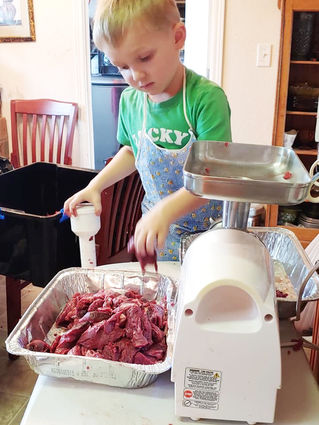River Ramblings North
November 20, 2019
As I was processing the last of the ripe tomatoes that I picked green before the first snowstorm of the season, I got thinking about my mom, how she kept ten people fed, clean, and healthy. Amazing how she canned hundreds of quarts of vegetables and meats for the year. I was having trouble with one sick little boy, and getting anything done. The ferry was my first priority after taking care of my grandson. Then the chickens because I have food and water set-up so they can go for days without me, then cooking and cleaning. I was ever thankful for having prepared broths and soups in the freezer from the last few butcherings. I was taught that nothing is tossed. So, when you debone the meat you are processing, the bones go into a pot with seasoning, and the broth is made. The same goes for vegetable peelings. They go into a pot, and the broth is made. Chicken backs and necks went into a pot and used later.

One of my ferry customers and I started a conversation about processing our wild game while crossing the river. We talked about processing meat for the winter. I had just put up my roosters and now its hunting season. We were talking about the slaying of the animal. How it is painful to watch or do but essential for survival. I pointed to the leaning 300-year-old cottonwood tree on the bank and told the story of my dad using that tree to hang our meat on each fall to cool for processing.
We raised pigs and chickens for half our meat supply and then wild game for the other half. When it was time to butcher pigs, it was a big ordeal. The fire was made, a 50-gallon drum was placed on it and filled with water. When it was scalding hot, it was time to slaughter the pigs. I hated this part. When you kill a pig, it makes a high-pitched squeal for a second or two. I would go to the house for this part. It was such a sad sound. But my dad would tell me that it had to be done to feed us after the slaughtering of the pigs all hands-on deck. My dad would dip the pigs in the scalding water and hang them in the tree. We all had scrapers, and we would scrape the hair off the hide. While we were doing that, my mom would harvest the heart, liver, and intestines. We usually ate the hearts for the first meal after harvesting them. The liver and onions were prepared once a week. The intestines were rolled inside out, and mom would take a pair of knitting needles, hold them side by side and pull the intestine through them. This cleaned off the inner tissues. When she had this process completed, she soaked them in saltwater and refrigerated until the sausage was prepared a couple of days later. The intestines were stuffed and smoked in my dad's homemade smoker to enjoy all year long.
Just thinking about these times makes me think about all the wonderful things we got from the pigs. My mother took the rind and fat and rendered it for lard. She used this all year. But the best part for me was the cracklings leftover from the renderings. When it had some skin left on, it was so much better than the pork rinds you get today. Every time mom took the pan from the oven to collect the lard, we would gather and take a hunk of the rendered rind. So good!
You never know what conversation you will strike upon the ferry or what will spark good memories. My girls tell me that in a 3-minute ride across the ferry, I know more about the people crossing than most people learn about each other all day. So, I encourage you all to take 3-minutes from your day to strike up a conversation and see what great stories and memories are made.
I hope these stories spark some good memories for you!

